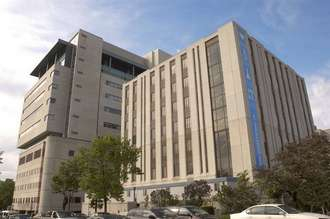 The Lady Davis Institute for Medical Research (LDI) opened its doors in 1969, some 30 years after the founding of its parent institution, the Jewish General Hospital (JGH). The LDI has strong academic links to McGill University, and is one of the most productive hospital-based research institutes in Canada and Quebec in terms of peer-reviewed grant funding per square feet. The LDI boasts more than 200 researchers, 100 administrative and support staff, and about 175 post-graduate students and post-doctoral fellows who receive their research training at the Institute yearly. Several members of the Department of Neurology & Neurosurgery base their research at the LDI, focusing on neurodegenerative diseases, brain aging, neuroplasticity, stroke recovery, Alzheimer's Disease, language and memory functions, and neuroepidemiology amongst others.
The Lady Davis Institute for Medical Research (LDI) opened its doors in 1969, some 30 years after the founding of its parent institution, the Jewish General Hospital (JGH). The LDI has strong academic links to McGill University, and is one of the most productive hospital-based research institutes in Canada and Quebec in terms of peer-reviewed grant funding per square feet. The LDI boasts more than 200 researchers, 100 administrative and support staff, and about 175 post-graduate students and post-doctoral fellows who receive their research training at the Institute yearly. Several members of the Department of Neurology & Neurosurgery base their research at the LDI, focusing on neurodegenerative diseases, brain aging, neuroplasticity, stroke recovery, Alzheimer's Disease, language and memory functions, and neuroepidemiology amongst others.
The LDI's Bloomfield Centre for Research in Aging (BCRA) is the sole research centre of its kind in Canada, supporting research in all areas of aging and neurodegenerative diseases, concentrating on cellular and molecular mechanisms of healthy aging and age-related diseases. The BCRA researchers also study the societal impacts on the aging and health care delivery systems for the elderly.
Several departmental members are active LDI principal investigators.
Dr. Hyman Schipper is investigating the role of the stress protein, heme oxygenase-1 (HO-1) in the pathological deposition of iron and oxidative mitochondrial damage in the aging and degenerating central nervous system. Dr. Schipper has successfully modeled Parkinson disease and schizophrenia in transgenic mice over-expressing HO-1 in astrocytes. He is also developing diagnostic biomarkers of these diseases based on measurements of HO-1 and related microRNAs in human saliva.
Dr Thiel’s neuroplasticity laboratory at the JGH is the first non-invasive brain stimulation laboratory on an acute stroke-unit in Canada. Using molecular imaging methods (PET), diffusion tensor imaging and transcranial magnetic stimulation, his research seeks to understand the pathophysiology of post-stroke recovery. The clinical projects of his research seek to translate these findings into clinical applications. These studies employ non-invasive brain stimulation techniques like TMS or tDCS to facilitate language and motor recovery after stroke. Dr. Thiel is the national lead investigator of CanStim, the Canadian platform for research in non-invasive brain stimulation.
Dr. Oliver Lasry’s research program focuses on improving the quality of surveillance and epidemiological research of non-traumatic spinal cord injuries (ntSCIs) in the general population. Dr. Lasry has developed quantitative methods to improve the utility of administrative health data to conduct timely and resource-friendly ntSCI surveillance and to validly investigate interventions that mitigate the significant ntSCI burden on society.
To learn more about the BCRA and the many LDI research labs, Principal Investigators, and trainees please visit http://www.ladydavis.ca/en/researchers.